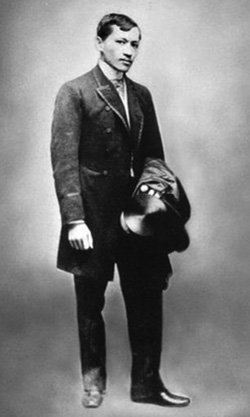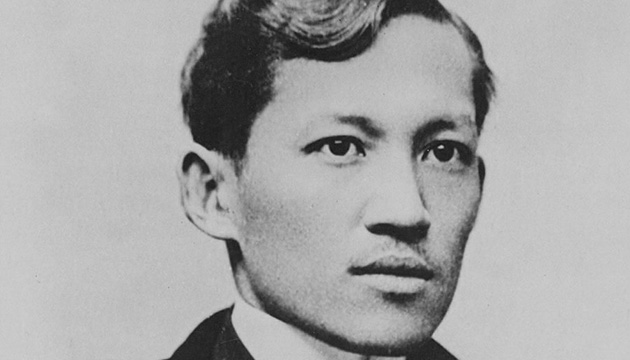Philippine National Hero Jose Rizal wrote most of his famous works in Spanish. Even his farewell poem, Mi Ultimo Adios, was written in the language of his executioners. He was, after all, a man of his times, when few educated Filipinos wrote formally in their own language. More than a century later, little has changed except that the foreign language is now English.
But Rizal was not a malansang isda (stinking fish) who neglected his own language. Throughout his short life, he worked to enrich Tagalog literature and to make it more accessible to ordinary people. He translated European stories into Tagalog such as Friedrich Schiller’s Wilhelm Tell and the fairy tales of Hans Christian Andersen. He wrote a short manuscript on Tagalog grammar and he also attempted to write his third novel in Tagalog, known today as Makamisa, but it was left unfinished when he was executed in 1896.
 While Rizal promoted indigenous literature, he also recognized the need to spread literacy among ordinary Filipinos. The first obstacle that Filipino children faced when learning to read and write, if they had the chance, was mastering the confusing method of spelling native words with the Spanish alphabet. Rizal got the idea to formulate better ways to spell Tagalog words using the modern alphabet after he read an 1884 essay by Trinidad Pardo de Tavera about the pre-colonial baybayin alphabet.
While Rizal promoted indigenous literature, he also recognized the need to spread literacy among ordinary Filipinos. The first obstacle that Filipino children faced when learning to read and write, if they had the chance, was mastering the confusing method of spelling native words with the Spanish alphabet. Rizal got the idea to formulate better ways to spell Tagalog words using the modern alphabet after he read an 1884 essay by Trinidad Pardo de Tavera about the pre-colonial baybayin alphabet.
In an article published in La Solidaridad in April of 1890, Rizal wrote:
“...it occurred to me to do something to lighten the work and make easy the first attempts of children to learn by simplifying the orthography [spelling], introducing another, more rational and more logical, which would be in harmony with the spirit of the language itself and of its sister languages...”
Tagalog spelling at that time followed the rules of the Spanish alphabet, which does not use the letters k and w except in borrowed foreign words. Before Rizal, spelling all the k syllables was not as straightforward as it is today – ka, ke, ki, ko, ku were spelled ca, que, qui, co, cu. This made learning Tagalog grammar much more difficult than it should have been. One example in Rizal’s 1890 article was the word katay (to butcher). This was normally spelled catai but when the past tense was needed (butchered), the spelling changed radically to quinatai. By adopting the letter k, Tagalog spelling immediately became more consistent and logical. The past tense of katay was predictably kinatay. The g syllables had similar difficulties. Ga, gegi, go and gu were spelled ga, gue, gui, go and gu. Rizal favoured dropping the letter u and using the letter h for the aspirated Spanish g; as in words like heneral.
Rizal’s proposal to drop the letters c and q in favour of k did not please everybody. Some people accused him of being unpatriotic because the letter k was supposedly a German letter, and Germany was one of Spain’s rivals. But Rizal was not alone in his struggle. At the same time that he was developing his ideas for Tagalog spelling, two of his contemporaries were doing the same thing independently, and they even went further in their reforms.
Trinidad Pardo de Tavera was the first to use the English form of the w in Tagalog writing in his 1887 essay Sanskrit in the Tagalog Language and Pedro Serrano Laktaw might have been the first to use the k– according to Rizal biographer, Austin Craig. Laktaw published his Hispano-Tagalog dictionary in 1889 using the new spelling, including the k and the w and he even changed the spelling of his own name from Lactao to Laktaw. As soon as Rizal saw what he described as the “more perfect orthography,” of Tavera and Laktaw, he became an enthusiastic supporter and gave them full credit for their ideas in his article of 1890.
The addition of the letter w helped to simplify spelling, too. In the old spelling, the sound of w was represented by either o or u but in no particularly logical way. The word awa (mercy) was spelled aua but araw (sun or day) was spelled arao. The Pampanga town originally known as Wawa (river mouth) was spelled Guagua, and like many place names and family names, the old Spanish spelling persists to this day.
Not all the innovations were winners, though. In the 1880s the sound of ng was written as ng, with a tilde over the g˜. Rizal and Tavera agreed that this complex combination of characters had to be stripped down to only one letter as it was in the pre-colonial baybayin alphabet. They proposed that the ng sound should be represented by the letter g alone with a tilde above it. Words such as magulang (parents) and marunong (knowledgeable) would have been spelled magulag˜ and marunog˜, but as we can see today, this idea did not survive. (Download a PDF version of this article to see the special characters.)
Jose Rizal did not overhaul Tagalog spelling single-handedly but his prominence as a writer probably did the most to advance the reforms. Members of the Propaganda movement including Mariano Ponce and Marcelo H. del Pilar quickly adopted the new spelling. It was also integral to the identity of the revolutionary Katipunan society that was formed in 1892. The k was prominent in the group’s name, Kataas-taasangKagalang-galangangKatipunan ng mgaAnak ng Bayan and in the name of their short-lived newspaper, Kalayaan. The letter k was also featured in several Katipunan flags, both in its Latin form and as the pre-colonial baybayin character.
Rizal’s writing, his exile, and his execution inspired Filipinos to rebel against Spanish colonial rule. But the most tangible part of his legacy, which Filipinos continue to experience everyday, is the way we spell Filipino words.
Sources:
Rizal, Jose. “Sobre la Nueva Ortografia de la LenguaTagala” in La Solidaridad, Vol II, p. 88-92. 15 April 1890. English translation from Miscellaneous Writing of Dr. Jose Rizal. NHI 1992.
Rizal, Jose. Letter to Ferdinand Blumentritt, April 5, 1896. The Rizal – Blumentritt Correspondence. Vol. II 1890 – 1896. NHI 1992
Rosales, Antonio B.L. “Rizal, Father of Modern Tagalog” in Philippine Magazine. December 1936, January 1937.


